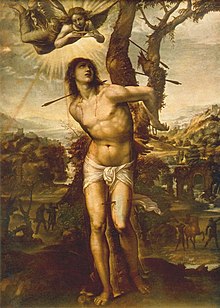In this painting by Gerrit van Honthorst four bloody arrows pierce Saint Sebastian’s seemingly lifeless body. One has stabbed through his leg, and a stream of blood seems to enter our space from its tip. The saint was a Roman centurion who converted to Christianity and, in punishment, the Roman Emperor Diocletian ordered Sebastian’s fellow soldiers to tie him to a post and shoot him with arrows. Sebastian’s tormented body takes centre stage in Honthorst’s painting. The beautiful torso echoes classical sculpture, like the Belvedere Torso, which had been admired by artists in Rome since the fifteenth century. At the same time, the saint’s physical suffering was intended to inspire devotion: viewers were prompted to imagine his intense pain and the strength of his faith. Honthorst must have seen many depictions of the saint’s martyrdom during the period that he worked in Rome, but he likely painted this work a few years after he returned to his native Utrecht in 1620. There were a number of outbreaks of the plague in Utrecht between 1624 and 1626, and Sebastian was revered as a ‘plague saint’, believed to offer protection against the deadly and highly contagious disease. Oil on canvas, The National Gallery, London.
胡適先生給這些「有福之人」取了個名字,叫「箭垛式人物」。他說:「古來有許多精巧的折獄故事,或載在史書,或流傳民間,一般人不知道他們的來歷,這些故事遂容易堆在一兩個人身上。在這些偵探式的清官之中,民間的傳說不知怎樣選出了宋朝的包拯來做一個箭垛,把許多折獄的奇案都射在他身上。包龍圖遂成了中國的歇洛克·福爾摩斯了。」
採用的標題,多少可說明作者的"國文程度"。
<果然有話>魏德聖的箭垛式冤情(張大春) | 蘋果日報
https://tw.appledaily.com/forum/daily/20100921/32828948 - Translate this page
Sep 21, 2010 - 箭垛式人物」是胡適的發明—在《三俠五義》的序裡,胡適開宗明義地說:「歷史上有許多有福之人。一個是黃帝,一個是周公,一個是包龍圖。」此一立論 ...「箭垛效應」類似「馬太效應」.......
吳音寧的「被箭靶人生」
May 30, 2018
|
箭垛
| 注音: | |
| 漢語拼音: | jiàn duǒ |
解釋:
| |



沒有留言:
張貼留言